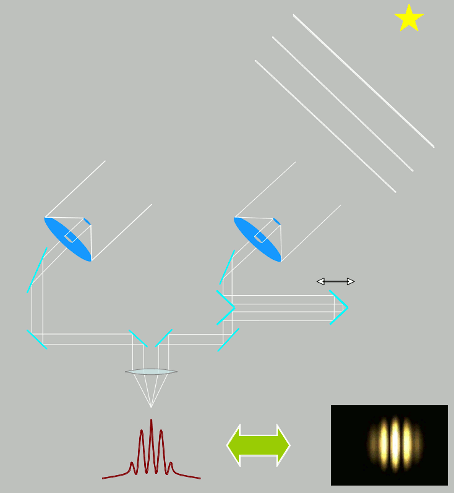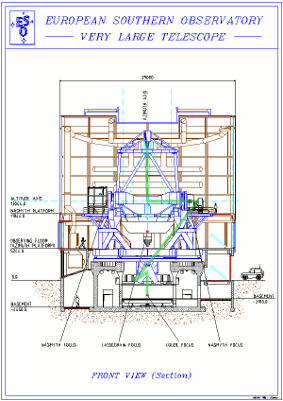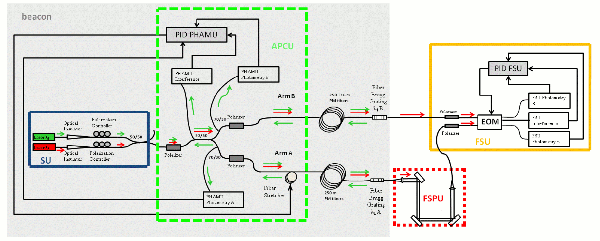MAMMUT: mirror vibration metrology for the VLTI
Since light consists of waves, the theoretical resolution of a telescope depends on its aperture. Unfortunately, turbulences of the atmosphere limit the resolution even of the largest telescopes to 0.6″ – 1.0″. With Adaptive Optics one can reach the diffraction limit, i.e. better resolution (about 0.1″, depending on the wavelength and aperture size). Using astronomical interferometry these limits can be overcome. An astro-interferometer consists of two or more distant telescopes the gathered light of which can interfere with each other. This way a resolution can be achieved close to the limiting resolution of single telescopes with their apertures equal to the separation between the two telescopes of the interferometer.
The light from a star that will be combined in an interferometer must propagate through two different passages of equal length (Fig. 1). “Equal” means, the difference must be clearly smaller than the wavelength of the light. To achieve this, several high-precision controlling systems are used to compensate for earth's movement and atmospheric turbulences. Such controllers cannot yet compensate for all vibrations.
 |
| Fig. 1: Main principle of an astro-interferometer |
One of the biggest interferometers in the world is the “Very Large Telescope Interferometer” (VLTI) of the European Southern Observatory ESO in Chile.
Fast mechanical vibrations, originating in the VLTI infrastructure cause fast and large changes of the Optical Path Difference (OPD) [1, 2]. Their compensation is required in order to access the full sensitivity of the instrument. In the joined project MAMMUT (Mirror vibrAtion Metrology systeM for the Unit Telescope) of the Friedrich-Schiller-University of Jena (Astrophysical Institute and Institute of Applied Physics) and ESO, a system was developed aimed at evaluating the potential of telecom fiber technology for mirror vibration sensing.
The ultimate goal is to monitor the OPD changes between mirrors number 2 (M2) and 9 (M9, Coudé room) of the Unit Telescope (UT, Fig. 2). As a result of the initial study phase, we have built and tested a 250+250-meter-long actively stabilized fiber interferometer which can be used as a coherent beacon for mirror vibration metrology by means of active homodyne detecion [3].
 |
| Fig. 2: MAMMUT will measure vibrations occuring between M2 and Coudé focus (based on a figure from “The VLT White Book”, ESO 1998) |
To benchmark the performance of MAMMUT several minimal requirements have been selected at the beginning of the project:
-
Operation wavelengths: 1353 nm & 1368 nm
-
Measured frequency range: 1 – 100 Hz
-
Maximum acceptable power spectral density (PSD) of noise in the measurements: ≤ 1 nm²/Hz (in the range of 1 – 100 Hz)
-
Maximum detectable stroke: ≥ ±5 µm, excluding DC component
MAMMUT consists of two units: an actively stabilized fiber interferometer ('beacon') and a Fringe Sensor Unit (FSU). The system uses two laser diodes operating at close wavelengths in the near-IR J band (λ1, λ2).
 |
| Fig. 3: Conceptual scheme of the laboratory prototype of MAMMUT. Main subsystems: Source Unit (SU), Active Phase Control Unit (APCU), Free-Space Propagation Unit (FSPU), and Fringe Sensor Unit (FSU) |
Internal metrology of the fiber interferometer:
λ1 (green in Fig. 3) is reflected by Fiber Bragg Gratings and recombined at the Phase Measurement Unit (PHAMU) of the Active Phase Control Unit (APCU). The calculated OPD is used by a PID controller to drive the Fiber Stretcher.
Mirror vibration measurement:
λ2 (red in Fig. 3) is injected into Free-Space Propagation Unit (FSPU) and coupled back into the input fiber of the FSU, where it is mixed with the reference channel provided by the second arm of the interferometer. By means of active homodyne technique the FSU calculates the phase distortions experienced at the FSPU from the feedback signal applied to the electro-optical modulator (EOM) [4].
The software for controlling MAMMUT was realized using LabVIEW™ and runs on a Real-time Desktop PC (LabVIEW™ is a trademark of National Instruments. This publication is independent of National Instruments, which is not affiliated with the publisher or the author, and does not authorize, sponsor, endorse or otherwise approve this publication).
The prototype of MAMMUT was delivered to the ESO in 2012 for evaluation and testing at the VLT on Cerro Paranal.
References
[1] Di Lieto, N., Sahlmann, J., Wallander., A., and Vasisht, G. “An approach to stabilizing large telescopes for stellar interferometry”, Proc. ICALEPCS, (2007).
[2] Sahlmann, J., Abuter, R., Di Lieto, N., Ménardi, S., Delplancke, F., Bartko, H., Eisenhauer, F., Léveque, S., Pfuhl, O., Schuhler, N., van Belle, G., Vasisht, G. “Resluts from the VLTI-PRIMA fringe tracking testbed”, Proc. SPIE 7013, 70131A-70131A-12 (2008)
[3] Liu, K. and Measures R., M., “Signal processing techniques for interferometric fiber-optic strain sensors” Journal of Intelligent Material Systems and Structures 3, 432, (1998).
[4] Minardi, S., Chipouline, A., Krämer, S., Pertsch, T., Follert, R., Stecklum, B., Neuhäuser, R., “An active fiber sensor for mirror vibration metrology in astronomical interferometers” Astron. Nachrichten 330, 518-522 (2009).
[5] Spaleniak, I., Giessler, F., Geiss, R., Minardi, S., Pertsch, T., Neuhaeuser, R., Becker, M., Rothhardt, M., Delplancke, F., Richichi, A., Ménardi, S., Schmid, C., “MAMMUT: mirror vibration metrology for VLTI”, Proc. SPIE 7734, 77343Y (2010)